#azhdarchoidea
Text

#is it me or are the weird dogs getting bigger#he looks hungry#should i?#should i do it?#should I give him a French fry#french fries#weird#strange#weird horse#weird dog#there’s a weird horse in my yard#weird dog series#lacusovagus#chaoyangopterid#chaoyangopteridae#azhadarchid#azhdarchidae#azhdarchoid#azhdarchid#azhdarchoidea#crato formation#night#pterosaurs but now#pterosaur post#pterosaur#avemetatarsalia#paleontology#paleoart#art#cretaceous
700 notes
·
View notes
Photo

Sketch_Hateful Hatzegopteryx.
Pencils, 2022.
#paleoart#extinct animals#pterosaur#pterodactyloid#Azhdarchoidea#hatzegopteryx#toon#pencils#sketches & doodles
31 notes
·
View notes
Note
Okay, so, I don't know how much specific interest you may or may not have in pterosaurs, I can't recall seeing you mention them before (but also my memory is... ummm...).
So basically, which gender are you, rhamphorhynchoid or pterodactyloid?
As with any favorite or binary choosing question, especially about gender and extinct life, I can't choose! But if I had to, I would choose rhamphorynchoids. They're honestly cute in a way, and so much more elegant than those dirty, clumsy looking, dopey pterodac- *stabbed*
Agh
Oh god
Oh no
Oh fuck

All glory to Pterodactyloidea.
All glory to Tapejara.
All glory to Hatzegopteryx.
All glory to Quetzalcoatlus.
All glory to Azhdarchoidea.
33 notes
·
View notes
Text
PRIMALVERSE: Dino Thunder
So basically this is an alternate universe of the whole Power Rangers Timeline, and just throw in a fan team and here we have Power Rangers Primal Gems. To be honest, the first change in the timeline is in Dino Thunder because in canon the Dino Gems were on the Meteor that wiped out all Dinosaurs excluding birds, but the thing that needs to be fixed is the chronological and geographical location.
The meteor landed in the Yucatan Peninsula and made the Chixculcub (I cannot remember the spelling okay!) Crater, which is in Mexico yet the Dino Gems bonded with the Tyrannosaurus and Triceratops which were both a few thousand miles north plus the Pteranodon which went extinct long before the K-PG extinction, same with the Brachiosaurus and Tupuxuara. So, it would make more sense for the Dino Gems to bond with prehistoric creatures of closer proximity.
Red Dino Gem: Tyrannosaurus ➡️ Bistahieversor

The Bistahieversor is a slightly smaller relative of the Tyrannosaurus, not from Mexico, but New Mexico, only because there are surprisingly very few large Tyrannosauroids in Mexico.
Blue Dino Gem: Triceratops ➡️ Coahuilaceratops

This one makes more actual sense, both Triceratops and Coahuilaceratops are chasmosaurines, long frilled ceratopsians, and are closer to each other than Bistahieversor is to Tyrannosaurus. Coahuilaceratops is named after a city in Mexico called Coahuila, or is it a rock outcrop?
Yellow Dino Gem: Pteranodon ➡️ Muzquizopteryx

The Muzquizopteryx was discovered in the same region as the Coahuilaceratops, plus it’s within the clade “Pteranodontia”, so it fits quite well.
Black Dino Gem: Brachiosaurus ➡️ Alamosaurus

The Alamosaurus was a titanosaur, so it was GIGANTIC, more fitting for a carrier zord and possibly big enough to be given a MegaZord…? Alamosaurus was discovered in Texas in the Ojo Alamo formation and it is the closest sauropod to Mexico because by the time K-PG extinction rolled around, the Alamosaurus was the only sauropod in North America.
White Dino Gem: Tupuxuara ➡️ Quetzalcoatlus
The Quetzalcoatlus and Tupuxuara are both apart of the clade, Azhdarchoidea, so it works out well. Plus I don’t even think I need an image for the Quetzalcoatlus, it’s quite well known thanks to the movie Jurassic World Dominion.
Other than all that, Dino Thunder is the same as in canon.
#power rangers au#Primal Gems#Does this apply for Paleoblr?#power rangers rp#yes this an RP blog.#don’t question it#power rangers dino thunder#dino thunder#I just realized that this is semi-educational.
1 note
·
View note
Photo
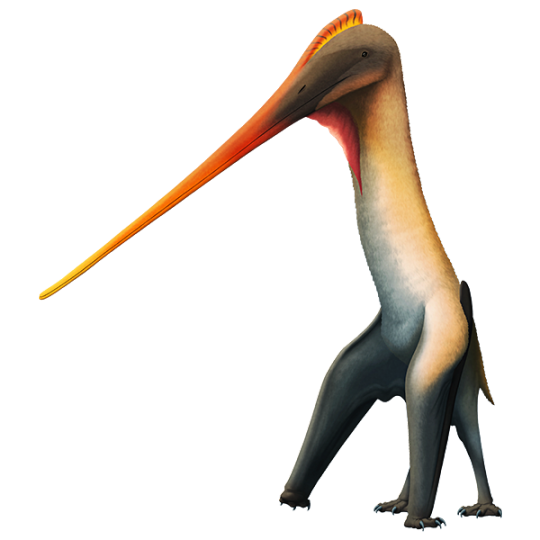
Leptostomia begaaensis here is a recently-discovered pterosaur that lived during the mid-Cretaceous period, around 100 million years ago.
Its fossil remains were found in the Kem Kem beds of Morocco – ancient river deposits famous for yielding some of the newer specimens of the bizarre aquatic dinosaur Spinosaurus – and consist of just a couple of small pieces of jaw bones.
But those fragments are rather weird for a pterosaur.
While it's hard to tell for certain from such meagre remains, Leptostomia might have been part of the azhdarchoid lineage, related to both the elaborately-crested tapejarids and the terrestrial-stalking giants like Quetzalcoatlus. And if it was indded an azhdarchoid it was an especially tiny one, possibly the smallest known member of the whole group. Based on the proportions of its relatives it would have stood just 30cm tall (1') with a wingspan of 60-70cm (2'-2'4"), roughly comparable in size to a modern pigeon.
And it had an incredibly long beak that tapered to a thin delicate tip, resembling the beaks of modern probe-feeding shorebirds more than any other known pterosaur. It may have been specialized for the same sort of ecological niche, poking around in mud and shallow water for small invertebrates and snapping them up, possibly detecting its hidden prey using super-sensitive nerve endings in the tip of its beak.
———
Nix Illustration | Tumblr | Pillowfort | Twitter | Patreon
#science illustration#paleontology#paleoart#palaeoblr#leptostomia#azhdarchoidea#pterodactyloidea#pterosaur#archosaur#art#convergent evolution#honestly wouldn't be surprised if the rest of this thing is also super weird#but the 'he beak too big for he gotdamn body' look is just too funny not to do
1K notes
·
View notes
Text

Aurorazhdarcho
Aurorazhdarcho – рід птерозаврів з надродини Azhdarchoidea, включає єдиний типовий вид – Aurorazhdarcho primordius. Жили наприкінці юрського періоду (верхній титонський вік, 150,8-145,0 млн років тому) на території сучасної Німеччини.
Повний текст на сайті "Вимерлий світ":
https://extinctworld.in.ua/aurorazhdarcho/
#aurorazhdarcho#pterosaur#late jurassic#jurassic period#paleoart#jurassic#paleontology#europe#germany#azhdarchoidea#aurorazhdarcho primordius#extinct animals#prehistoric#ukraine#ukrainian#палеонтологія#палеоарт#вимерлі тварини#доісторичні тварини#україна#українська мова#український tumblr#scientific illustration#art#scientific article#animals#history#creatures#science#наука
15 notes
·
View notes
Text
Bogolubovia orientalis

By Julio Lacerda; retrieved from http://www.pteros.com/, a website dedicated to education about Pterosaurs.
A reminder that we will not be able to do every pterosaur until we reach $240 in donations on our patreon, so please donate even a dollar if you can.
Name: Bogolubovia orientalis
First Described: 1989
Described By: Nessov
Classification: Avemetatarsalia, Ornithodira, Pterosauromorpha, Pterosauria, Macronychoptera, Novialoidea, Breviquartossa, Pterodactylomorpha, Monofenestrata, Pterodactyliformes, Caelidracones, Pterodactyloidea, Eupterodactyloidea, Ornithocheiroidea, Azhdarchoidea, Azhdarchidae
Bogolubovia is an Azhdarchid only known from a fragment of cervical vertebra which is now lost. It hailed from the Campanian Rybushka Formation of Russia (83-75 Ma, roughly). It was named as Ornithostoma orientalis in 1914, and then moved to its own genus Bogolubovia in 1989. It probably had a wingspan of around 4 meters. Not much else to say about it.
Source:
https://www.pteros.com/pterosaurs/bogolubovia.html
#bogolubovia#bogolubovia orientalis#azhdarchid#pterosaur#pterosaur ptuesday#pterodactyloid#azhdarchoid#palaeoblr#paleontology#prehistoric life#prehistory#biology#nature#science#factfile
99 notes
·
View notes
Text
Dinoetae AU Wildlife
Tyrannosaurids:
Tyrannosaurus Rex- 14ft tall
Dromaeosaurid:
Microraptorinae indet- 1ft tall
Acheroraptor- 2ft tall
Dakotaraptor- 6ft tall
Troodontidae:
Paronychodon- 2.5ft tall
Pectinodon- 3.5 ft tall
Coelurosauria:
Richardoestesia sp- 4ft tall
Ankylosauria:
Denversaurus- 5ft tall
Ankylosaurus- 6.5ft tall
Ornithomimosauria:
Orcomimus- 5ft tall
Ornithomimus- 6ft tall
Struthiomimus- 7ft tall
Sauropoda:
Titanosauridae indet- 30ft tall
Alamosaurus- 36ft tall
Ceratopsia:
Leptoceratops- 2.5ft tall
Tatankaceratops- 4ft tall
Nedoceratops- 11ft tall
Triceratops prorsus- 12ft tall
Triceratops horridus- 12.5ft tall
Torosaurus- 13ft tall
Parksosauridae:
Thescelosaurus garbanii- 3ft tall
Thescelosaurus neglectus- 5ft tall
Parvicursorinae:
Trierarchuncus- 2ft tall
Ornithomimus minutus- 2.8ft tall
Hadrosauridae:
Edmontosaurus annectens- 14ft tall
Lambeosaur indet- 10ft tall
Oviraptorosauria:
Caenagnathidae Indeterminate- 5ft
Elimisaurine indeterminate- 6ft
Anzu- 9ft
Pachycephalosauria:
Sphaerotholus- 2ft tall
Dracorex- 3ft tall
Stygimoloch- 4ft tall
Pachycephalosaurus- 5ft tall
Azhdarchoidea:
Quetzalcoatlus lawsoni- 8ft tall
Azhdarchidae spp- 12ft tall
Quetzalcoatlus northropi- 16ft tall
Pteranodontoidea:
Pteranodon longiceps female- 3.2ft tall
Geosternbergia female- 3.3ft tall
Pteranodontia indet- 4ft tall
Pteranodon longiceps male- 5.9ft tall
Geosternbergia male- 6ft tall
0 notes
Text
Ученые раскрыли пикантные подробности про летающего динозавра: фото
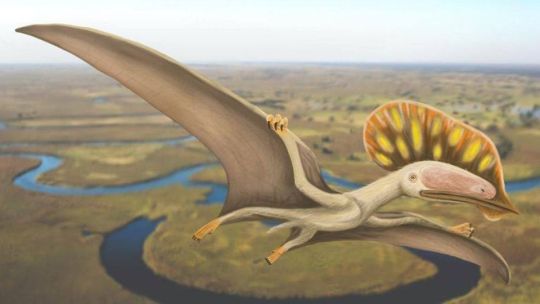
Палеонтологи Портсмутского университета определили, д��я чего был нужен птерозаврам, которые обитали на Земле в меловом периоде, крупный, красочный гребень на голове. Результаты исследования были опубликованы в журнале Cretaceous Research. В останках обнаруженного на острове Уайт (Великобритания) летающего динозавра семейства тапеяридов (Tapejarid) из надсемейства Azhdarchoidea ученые обнаружили яркий отличительный признак. По ... Читать далее
0 notes
Photo

Sketch_Tired Tupuxuara.
Pencils, 2020.
61 notes
·
View notes
Photo

Sketch_Quetzy Quetzalcoatlus.
Pencils, 2019.
#paleoart#extinct animals#pterosaur#pterodactyloid#Azhdarchoidea#quetzalcoatlus#toon#pencils#sketches & doodles
105 notes
·
View notes
Text
Navajodactylus boerei

By Midiaou Diallo; retrieved from http://www.pteros.com/, a website dedicated to education about Pterosaurs.
A reminder that we will not be able to do every pterosaur until we reach $240 in donations on our patreon, so please donate even a dollar if you can.
Name: Navajodactylus boerei
First Described: 2011
Described By: Sullivan and Fowler
Classification: Avemetatarsalia, Ornithodira, Pterosauromorpha, Pterosauria, Macronychoptera, Novialoidea, Breviquartossa, Pterodactylomorpha, Monofenestrata, Pterodactyliformes, Caelidracones, Pterodactyloidea, Eupterodactyloidea, Ornithocheiroidea, Azhdarchoidea, Neoazhdarchia, Neopterodactyloidea, ?Azhdarchidae
Navajodactylus is a medium-sized pterosaur (11.5 foot wingspan) that lived around 75 million years ago. The holotype, a partial wing, is a from the Kirtland Formation of New Mexico, with more material known from the DInosaur Park Formation Alberta, Canada. The wing is really weird - the first digit of the wing finger has an unusual shape of the extensor tendon process (the thing that connects into the metacarpal) that isn’t seen in any other pterosaur. It was referred to Azhdarchidae even though it doesn’t have many distinctively Azhdarchid features; at the time, no other non-Azhdarchid pterosaurs are known that lived inland.
Source:
Sullivan, R.M., Fowler, D.W. 2011. Navajodactylus boerei, n. gen., n. sp., (Pterosauria, ?Azhdarchidae) from the Upper Cretaceous Kirtland Formation (upper Campanian) of New Mexico”. New Mexico Museum of Natural History and Science, Bulletin 53: 393-404.
#navajodactylus#navajodactylus boerei#azhdarchid#pterosaur#pterosaur ptuesday#palaeoblr#azhdarchoid#pterodactyloid#paleontology#prehistoric life#prehistory#biology#nature#science#factfile
166 notes
·
View notes
Text
Phosphatodraco mauritanicus

By Joschua Knüppe ; retrieved from http://www.pteros.com/, a website dedicated to education about Pterosaurs.
A reminder that we will not be able to do every pterosaur until we reach $240 in donations on our patreon, so please donate even a dollar if you can.
Name: Phosphatodraco mauritanicus
First Described: 2003
Described By: Pereda-Suberbiola et al. 2003
Classification: Avemetatarsalia, Ornithodira, Pterosauromorpha, Pterosauria, Macronychoptera, Novialoidea, Breviquartossa, Pterodactylomorpha, Monofenestrata, Pterodactyliformes, Caelidracones, Pterodactyloidea, Eupterodactyloidea, Ornithocheiroidea, Azhdarchoidea, Neoazhdarchia, Neopterodactyloidea, Azhdarchidae
Phosphatodraco is yet another Azhdarchid. It lived at the very end of the Cretaceous (66 million years ago) in what is now phosphatic basins of Morocco (hence the name). The only fossils definitively known to be from this species are neck vertebrae - one series of five vertebrae, and another isolated one. The neck appears to not have been as elongated as in taxa like Quetzalcoatlus, implying it may have been a more basal Azhdarchid. Its wingspan is estimated at being around 16.4 feet. The deposit it’s known from was evidently marine, as evidenced by the hundreds of oceangoing pterosaurs. Presumably Phosphatodraco was terrestrial like other Azhdarchids, explaining its relative rarity.
Source:
https://www.pteros.com/pterosaurs/phosphatodraco.html
#phosphatodraco#phosphatodraco mauritanicus#azhdarchid#pterosaur#pterosaur ptuesday#palaeoblr#azhdarchoid#paleontology#prehistoric life#biology#nature#science#factfile
126 notes
·
View notes
Text
Eoazhdarcho liaoxiensis
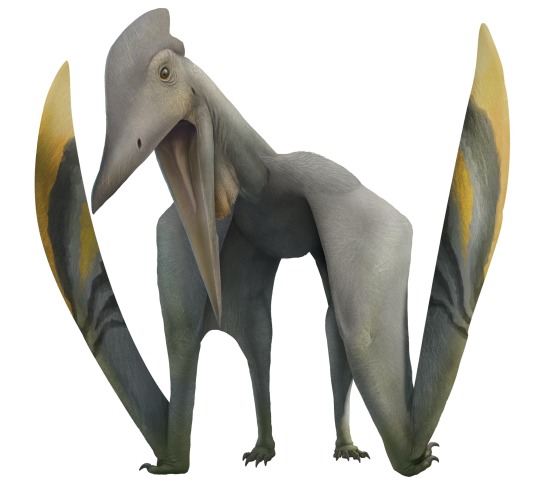
By Vitor Silva; retrieved from http://www.pteros.com/, a website dedicated to education about Pterosaurs.
A reminder that we will not be able to do every pterosaur until we reach $240 in donations on our patreon, so please donate even a dollar if you can.
First Described: 2005
Described By: Lu & Ji
Classification: Avemetatarsalia, Ornithodira, Pterosauromorpha, Pterosauria, Macronychoptera, Novialoidea, Breviquartossa, Pterodactylomorpha, Monofenestrata, Pterodactyliformes, Caelidracones, Pterodactyloidea, Eupterodactyloidea, Ornithocheiroidea, Azhdarchoidea, Chaoyangopteridae
Eoazhdarcho was so-named because it was thought to be the first Azhdarchid when it was exhumed from the Jiufotang Formation in 2005. This assignment was based on features such as long limbs, moderately elongate neck vertebrae, and a long toothless snout. This assignment didn’t last long, and in 2008 it was reassigned to Chaoyangopteridae - a group of pterosaurs with the same features also found in early Cretaceous China. Eoazhdarcho had a wingspan of about 1.6 meters (5.2 feet), and was probably omnivorous.
Source:
https://en.wikipedia.org/wiki/Eoazhdarcho
#eoazhdarcho#eoazhdarcho liaoxiensis#choyangopterid#pterosaur#pterosaur ptuesday#palaeoblr#azhdarchoid#pterodactyloid#paleontology#prehistoric life#prehistory#biology#science#nature#factfile
49 notes
·
View notes
Text
Hornby Island Azhdarchid
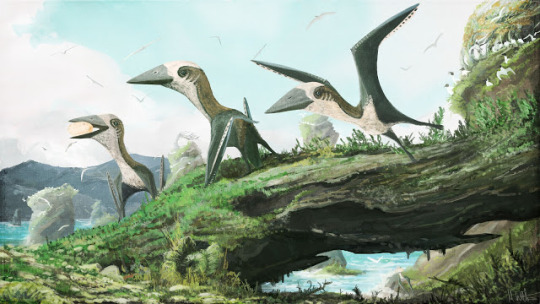
By Mark Witton, retrieved with permission from https://markwitton-com.blogspot.com/2016/08/new-paper-at-last-small-pterosaur.html
A reminder that we will not be able to do every pterosaur until we reach $240 in donations on our patreon, so please donate even a dollar if you can.
Name: Hornby Island Azhdarchid
First Mentioned: 2016
Mentioned By: Martin-Silverstone et al.
Classification: Avemetatarsalia, Ornithodira, Pterosauromorpha, Pterosauria, Macronychoptera, Novialoidea, Breviquartossa, Pterodactylomorpha, Monofenestrata, Pterodactyliformes, Caelidracones, Pterodactyloidea, Eupterodactyloidea, Ornithocheiroidea, Azhdarchoidea, Neoazhdarchia, Neopterodactyloidea, Azhdarchidae
The Hornby Island Azhdarchid is an as-yet unnamed Azhdarchid that is notable, more than anything, for its quite small size. At the end of the Cretaceous, essentially all pterosaurs were extremely large ones - Nyctosaurids, Pteranodontids, and the famed giant Azhdarchids. The common narrative was that smaller flying niches were being taken by the proto-birds of the day. However, when the Hornby Island Azhdarchid was discovered in the Northumberland Formation of Hornby Island, British Columbia, dating to about 75 to 72 million years ago, in the latest part of the Campanian of the Late Cretaceous, it threw this general assumption into chaos. The Hornby Island Azhdarchid was, by all accounts, quite small - its wingspan is about 1.4 meters or so in length.

By Joschua Knüppe, retrieved from http://www.pteros.com/, a website dedicated to education about Pterosaurs.
Before you shout “What about ontogeny!”, the researchers of this specimen did conduct experiments on that score - ie, histological ones, looking at sections of the bone to see its growth stages. It was still growing at the time of death, with extensive fibrous texture like that of other immature pterosaurs, however the relatively narrow vascular canals indicate it wasn’t a young pterosaur - and probably was a subadult, which is also corroborated by zonal bone growth and other features seen in older pterosaurs - the youngest it could be is really a late-stage juvenile. As such, it would have only gotten a little bit bigger than the original specimen, leading to that 1.4 meter long wingspan estimate for the adult. Compared to the wingspans of 2.5 to 3 meters of most pterosaurs of this time, it seems that small pterosaurs - cat sized pterosaurs - were still around up until the asteroid hit. Other small pterosaurs are found elsewhere at the same time, though they’re extremely rare and problematic. Given that pterosaurs with small wingspans are rare in many places in the fossil record, it is indeed a leap to suggest they were “replaced” by proto-birds. In addition, small animals in general aren’t really preserved well in the latest Cretaceous, from juveniles to adults, with the preservation of small individuals being notable finds. As such, this bias probably applies to pterosaurs as well.

From Martin-Silverstone et al. 2016 (By Mark Witton)
The Hornby Island Azhdarchid was probably most closely related to the huge Azhdarchids of Quetzalcoatlus and Hatzegopteryx, though the small pterosaur hasn’t been given its own name as of yet due to incomplete remains. It lived alongside two different types of small proto-birds, an Enantiornithine and an Ornithuran (so, on the line to modern birds), indicating the presence of small proto-birds did not lead to an “outcompeting” of small pterosaurs in the region. Instead, all three lived together in a coastal environment, probably using the nearby marine habitat for food (though, of course, the ecology of the Hornby Island Azhdarchid can’t be determined exactly unless more remains are found, though its reasonable to suppose it may have been a terrestrial predator like its relatives). Furthermore, small pterosaurs were probably more common throughout the Mesozoic than we gave them credit for - and it is only the preservation bias against them that has lead to us not finding their remains.
Sources:
https://www.pteros.com/pterosaurs/hornby-island-azhdarchid.html
https://markwitton-com.blogspot.com/2016/08/new-paper-at-last-small-pterosaur.html
Martin-Silverstone, E., M. P. Witton, V. M. Arbour, P. J. Currie. 2016. A small azhdarchoid pterosaur from the latest Cretaceous, the age of flying giants. Royal Society Open Science 3: 160333
http://fossilworks.org/?a=collectionSearch&collection_no=84196
#hornby island azdarchid#azdarchid#pterosaur#pterosaur ptuesday#azhdarchoid#palaeoblr#paleontology#prehistory#prehistoric life#biology#science#nature#factfile
284 notes
·
View notes
Text
Aralazhdarcho bostobensis
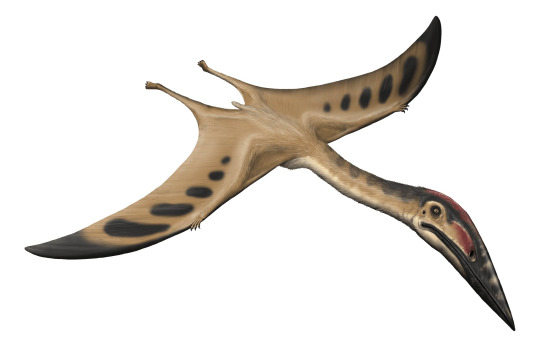
By Nathan Rogers; retrieved from http://www.pteros.com/, a website dedicated to education about Pterosaurs.
A reminder that we will not be able to do every pterosaur until we reach $240 in donations on our patreon, so please donate even a dollar if you can.
Name: Aralazhdarcho bostobensis
First Described: 2007
Described By: Averianov
Classification: Avemetatarsalia, Ornithodira, Pterosauromorpha, Pterosauria, Macronychoptera, Novialoidea, Breviquartossa, Pterodactylomorpha, Monofenestrata, Pterodactyliformes, Caelidracones, Pterodactyloidea, Eupterodactyloidea, Ornithocheiroidea, Azhdarchoidea, Azhdarchidae
Aralazhdarcho is an Azhdarchid known from a bunch of 85-80 million year old bone fragments. The holotype specimen is a partial neck vertebra, excavated from the Bostobe Formation in Kazakhstan. Other bones include those from the posterior skull, more vertebrae, a scapula, and bits of limbs. Going off the bone fragments, Aralazhdarcho was a relatively small azhdarchid, at only 3 meters (10 feet) in wingspan.
Source:
https://www.pteros.com/pterosaurs/aralazhdarcho.html
Averianov, A.O. 2004. New records of azhdarchids (Pterosauria, Azhdarchidae) from the late Cretaceous of Russia, Kazakhstan, and Central Asia. Paleontological Journal 41(2): 189-97.
#aralazhdarcho#aralazhdarcho bostobensis#azhdarchid#pterosaur#pterosaur ptuesday#palaeoblr#azhdarchoid#pterodactyloid#paleontology#prehistoric life#prehistory#biology#nature#science#factfile
45 notes
·
View notes